1993 CHEVROLET ASTRO PASSENGER light
[x] Cancel search: lightPage 165 of 345
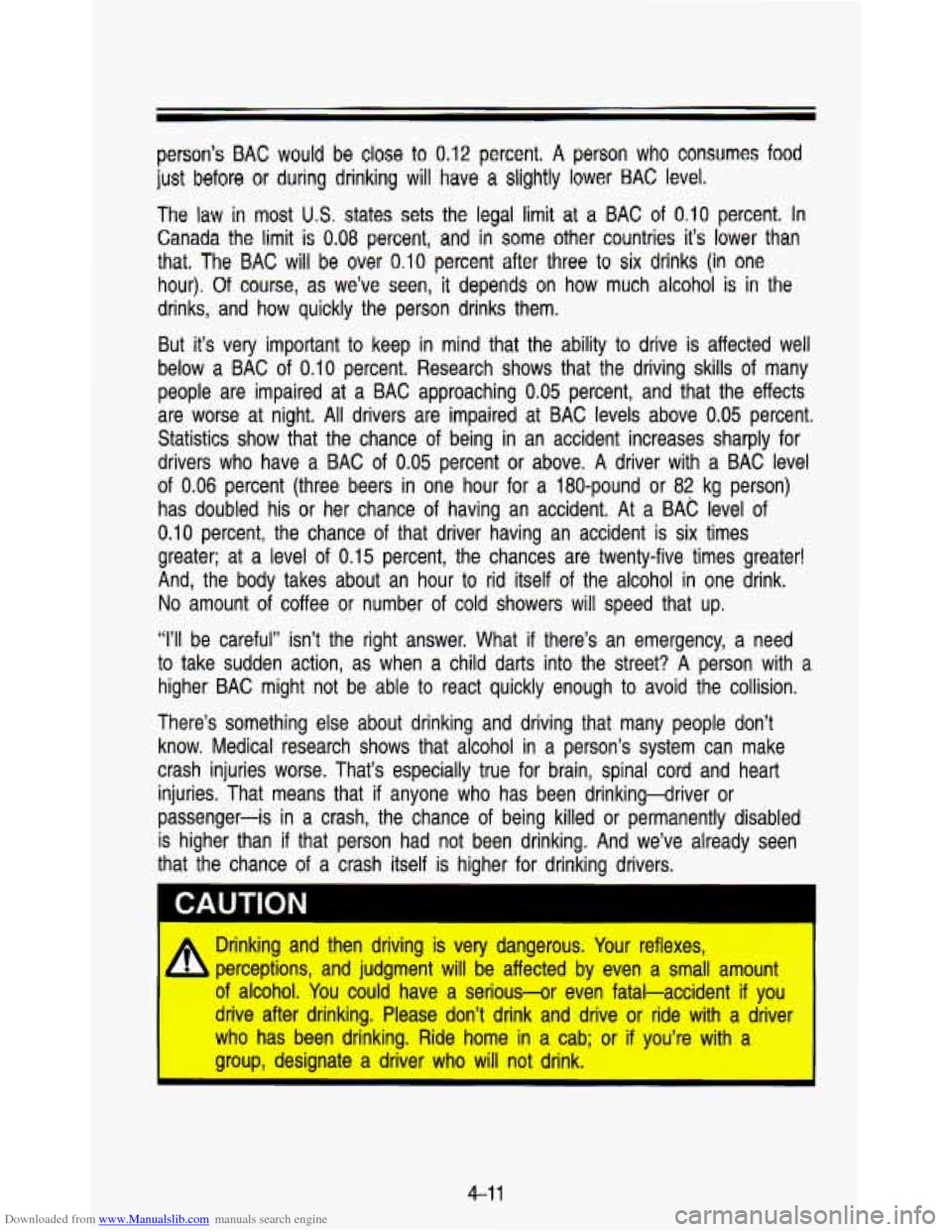
Downloaded from www.Manualslib.com manuals search engine person’s BAC would be close to 0.12 percent. A person who consumes food
just before or during drinking will have a slightly lower BAC level.
The law in most
US. states sets the legal limit at a BAC of 0.10 percent. In
Canada the limit is 0.08 percent, and in some other countries it’s lower than
that. The BAG will
be over 0.10 percent after three to six drinks (in one
hour). Of course,
as we’ve seen, it depends on how much alcohol is in the
drinks, and how quickly the person drinks them.
But it’s very important to keep in mind that the ability to drive is affected well
below a BAC of
0.10 percent. Research shows that the driving skills of many
people are impaired at
a BAC approaching 0.05 percent, and that the effects
are worse at night. All drivers are impaired at BAC levels above
0.05 percent.
Statistics show that the chance of being in an accident increases sharply for
drivers who have
a BAC of 0.05 percent or above. A driver with a BAC level
of
0.06 percent (three beers in one hour for a 180-pound or 82 kg person)
has doubled his or her chance of having an accident.
At a BAC level of
0.10 percent, the chance of that driver having an accident is six times
greater; at a level of
0.15 percent, the chances are twenty-five times greater!
And, the body takes about an hour to rid itself of the alcohol in one drink.
No amount of coffee or number of cold showers will speed that up.
“I’ll be careful” isn’t the right answer. What if there’s an emergency, a need
to take sudden action, as when a child darts into the street?
A person with a
higher BAC might not be able to react quickly enough
to avoid the collision.
There’s something else about drinking and driving that many \
people don’t know. Medical research shows that alcohol in a person’s system can\
make
crash injuries worse. That’s especially true for brain, spina\
l cord and heart
injuries. That means that
if anyone who has been drinking-driver or
passenger-is in a crash, the chance of being killed or permanently disabled
is higher than
if that person had not been drinking. And we’ve already seen
that the chance of a crash itself is higher for drinking drivers.
CAUTION
Drinking and then driving is very dangerous. Your reflexes,
[ perceptions, and judgment will be affected by even a small amo\
unt
of alcohol. You could have a serious-or even fatal-accident
if you
drive after drinking. Please don’t drink and drive or ride with a driver
who has been drinking. Ride home in a cab; or
if you’re with a
group, designate a driver who will not drink.
4-1 1
Page 167 of 345
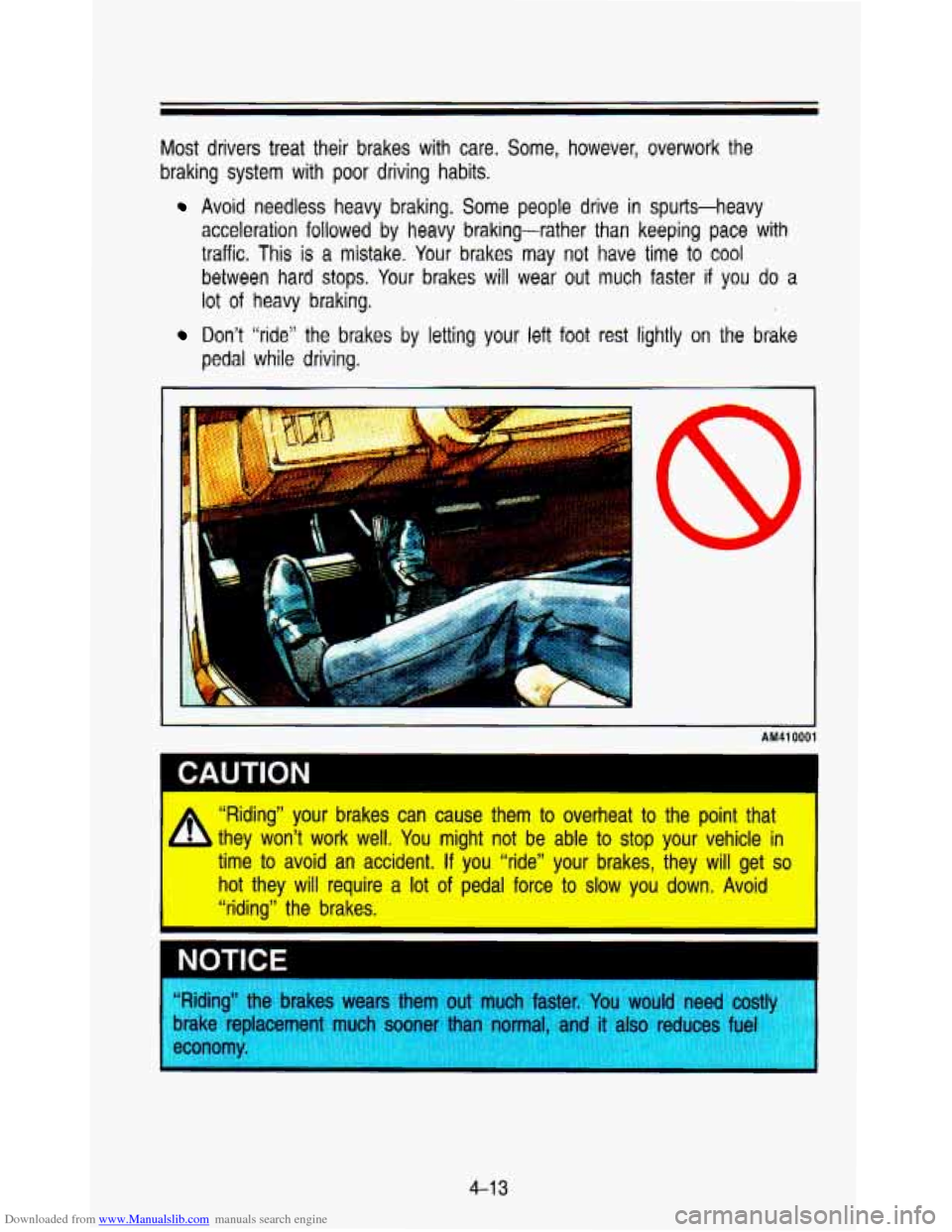
Downloaded from www.Manualslib.com manuals search engine Most drivers treat their brakes with care. Some, however, overwork the
braking system with poor driving habits.
Avoid needless heavy braking. Some people drive in spurts-heavy
acceleration followed by heavy braking-rather than keeping pace with
traffic. This
is a mistake. Your brakes may not have time to cool
between hard stops. Your brakes will wear out much faster if you do a
lot of heavy braking.
Don’t ”ride” the brakes by letting your left foot rest lightly on the brake
pedal while driving.
II
!
I AM410001
A
“Riding” your brakes can cause them to overheat to the point that
they won’t work well. You might not be able
to stop your vehicle in
time to avoid an accident.
If you “ride” your brakes, they will get so
hot they will require a lot of pedal force to slow you down. Avoid
“riding” the brakes.
1 CAUTION
I
NOTICE
“Riding .he brakes wears them out much faster. You would need costll
brake replacement much
sooner than normal. and it also reduces fuel
4-1 3
Page 170 of 345
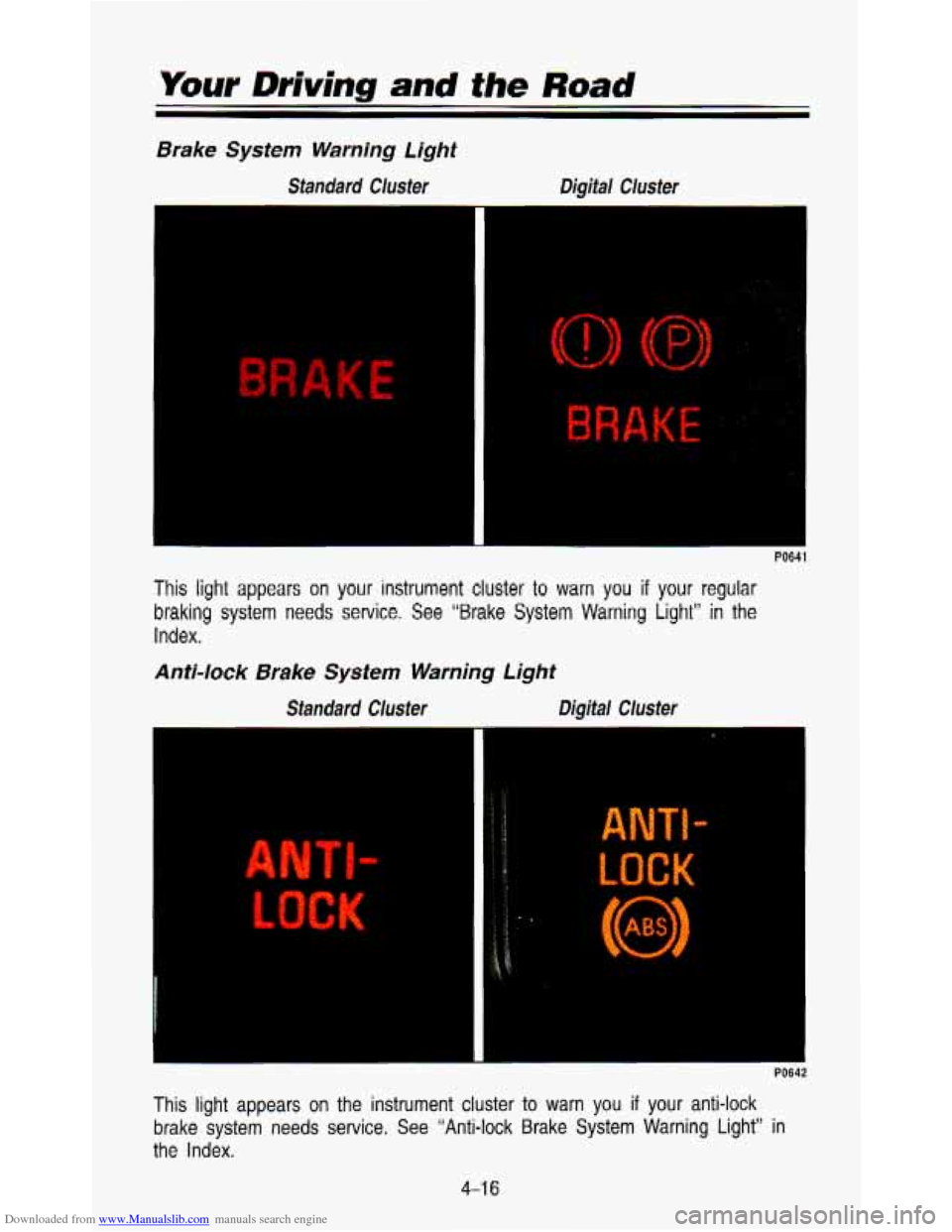
Downloaded from www.Manualslib.com manuals search engine Brake System Warning Light
Standard Cluster Digital Cluster
PO641
This light appears on your instrument cluster to warn you if your regular
braking system needs service. See “Brake System Warning Light” in the
Index.
Anti-lock Brake System Warning Light
Standard CIusfer Digital Cluster
This light appears on the instrument cluster to warn you if your anti-lock
brake system needs service. See “Anti-lock Brake System Warning Light” in
the Index.
4-1 6
Page 171 of 345
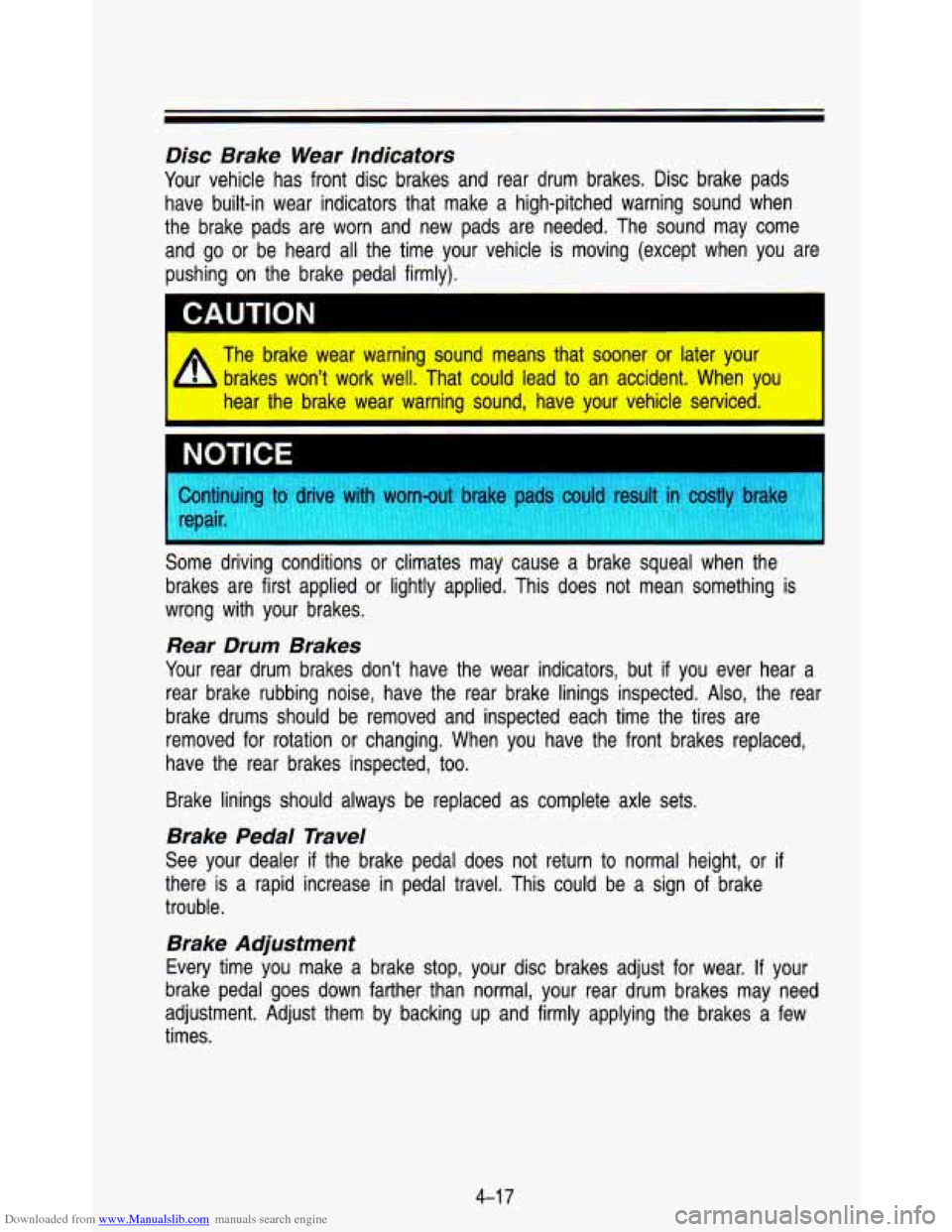
Downloaded from www.Manualslib.com manuals search engine Disc Brake Wear Indicators
Your vehicle has front disc brakes and rear drum brakes. Disc brake\
pads
have built-in wear indicators that make a high-pitched warning sound when
the brake pads are worn and new pads are needed. The sound m\
ay come and go or be heard all the time your vehicle is moving (except when you are
pushing on the brake pedal firmly).
I CAUTION
A The brake wear warning sound means that sooner or later your
4 brakes won’t work well. That could lead to an accident. When you
hear the brake wear warning sound, have your vehicle serviced. \
I
NCTICE
Some driving conditions or climates may cause a brake squeal when the
brakes are first applied or lightly applied. This does not mean something is
wrong with your brakes.
Rear Drum Brakes
Your rear drum brakes don’t have the wear indicators, but if you ever hear a
rear brake rubbing noise, have the rear brake linings inspected\
. Also, the rear
brake drums should be removed and inspected each time the tires are
removed for rotation or changing. When
have the rear brakes inspected, too.
Brake linings should always be replaced
Brake Pedal Travel
See your dealer if the brake pedal does
there
is a rapid increase in pedal travel.
trouble.
Brake Adjustment
Every time you make a brake stop, your you have
the front brakes replaced,
as complete axle sets.
not return to normal height, or
if
This could be a sign of brake
disc brakes adjust for wear.
If your
brake pedal goes down farther than normal, your rear drum brak\
es may need
adjustment. Adjust them by backing up and firmly applying the brakes a few
times.
4-1 7
Page 173 of 345

Downloaded from www.Manualslib.com manuals search engine When you drive into a curve at night, it’s harder to see the road ahead of
you because
it bends away from the straight beams of your lights. This is
one good reason to drive slower.
Steering in Emergencies
There are times when steering can be more effective than braki\
ng. For
example, you come over a hill and find a truck stopped in your lane, or a
car suddenly pulls
out from nowhere, or a child darts out from between
parked cars and stops right in front of you. You can avoid these problems by
braking-if you can stop in time. But sometimes you can’t; there isn’t room.
That’s the time for evasive action-steering around the proble\
m.
Your vehicle can perform very well in emergencies like these. First apply your
brakes.
It is better to remove as much speed as you can from a possible collision.
Then steer around the problem,
to the left or right depending on the space
available.
An emergency like this requires close attention and a quick decision.
If you
are holding the steering wheel at the recommended 9 and 3 o’clock positions,
you can turn
it a full 180 degrees very quickly without removing either hand.
But you have to act fast, steer quickly, and just as quickly straighten the
wheel once you have avoided the object. You must then be prepared
to steer
back to your original lane and then brake to a controlled stop.
4-1 9
Page 174 of 345
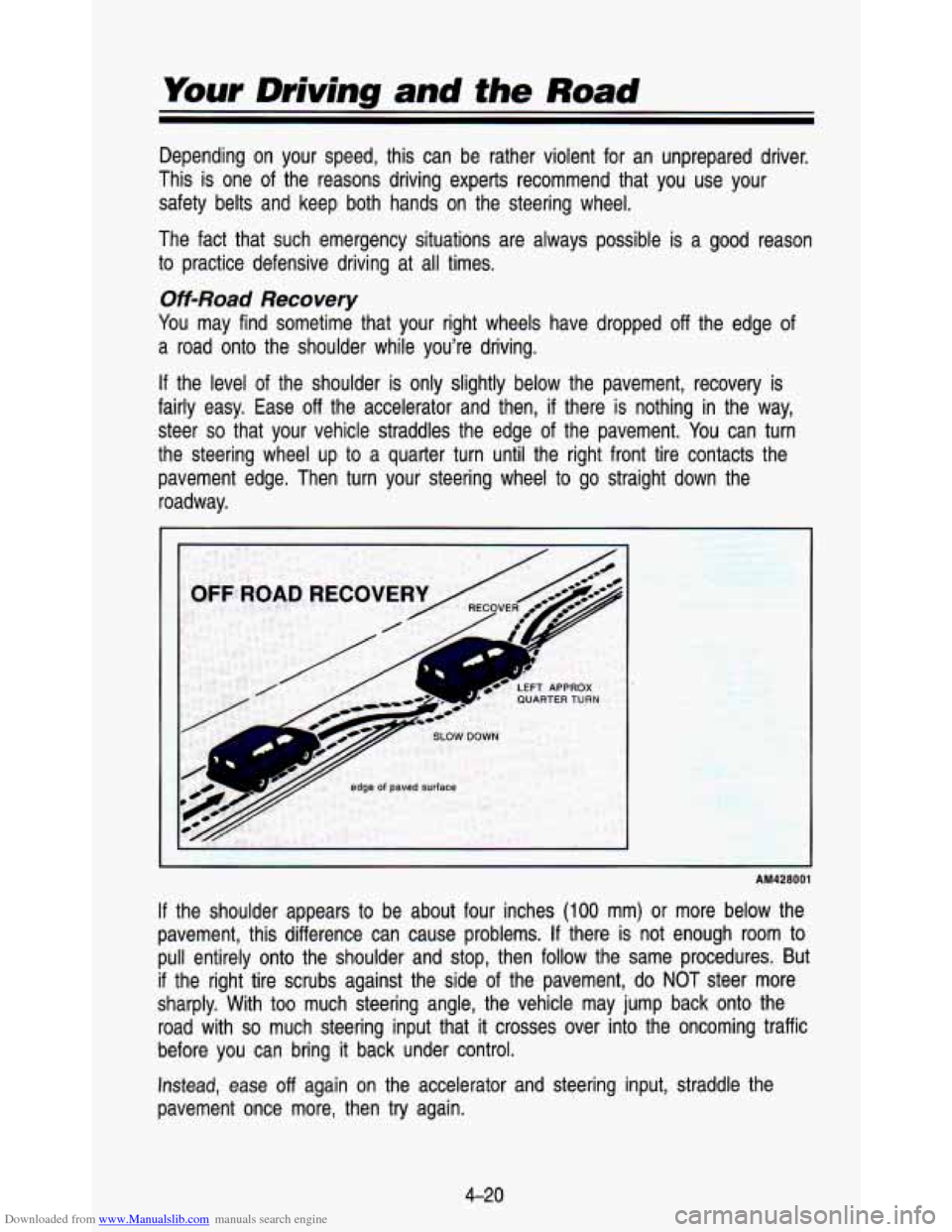
Downloaded from www.Manualslib.com manuals search engine Your Driving and the Road
Depending on your speed, this can be rather violent for an un\
prepared driver.
This is one of the reasons driving experts recommend that you use your
safety belts and keep both hands on the steering wheel.
The fact that such emergency situations are always possible is a good reason
to practice defensive driving at all times.
Off-Road Recovery
You may find sometime that your right wheels have dropped off the edge\
of
a road onto the shoulder while you’re driving.
If the level of the shoulder is only slightly below the pavement, recovery is
fairly easy. Ease off the accelerator and then, if there is nothing in the way,
steer
so that your vehicle straddles the edge of the pavement. You can turn
the steering wheel up to a quarter turn until the right front tire contacts the
pavement edge. Then turn your steering wheel
to go straight down the
roadway.
I
AM428001
If the shoulder appears to be about four inches (100 mm) or more below the
pavement, this difference can cause problems.
If there is not enough room to
pull entirely onto the shoulder and stop, then follow the same\
procedures. But
if the right tire scrubs against the side of the pavement, do NOT steer more
sharply. With too much steering angle, the vehicle may jump back onto the
road with
so much steering input that it crosses over into the oncoming traffic
before you can bring
it back under control.
Instead, ease off again on the accelerator and steering input, straddle the
pavement once more, then try again.
4-20
Page 176 of 345
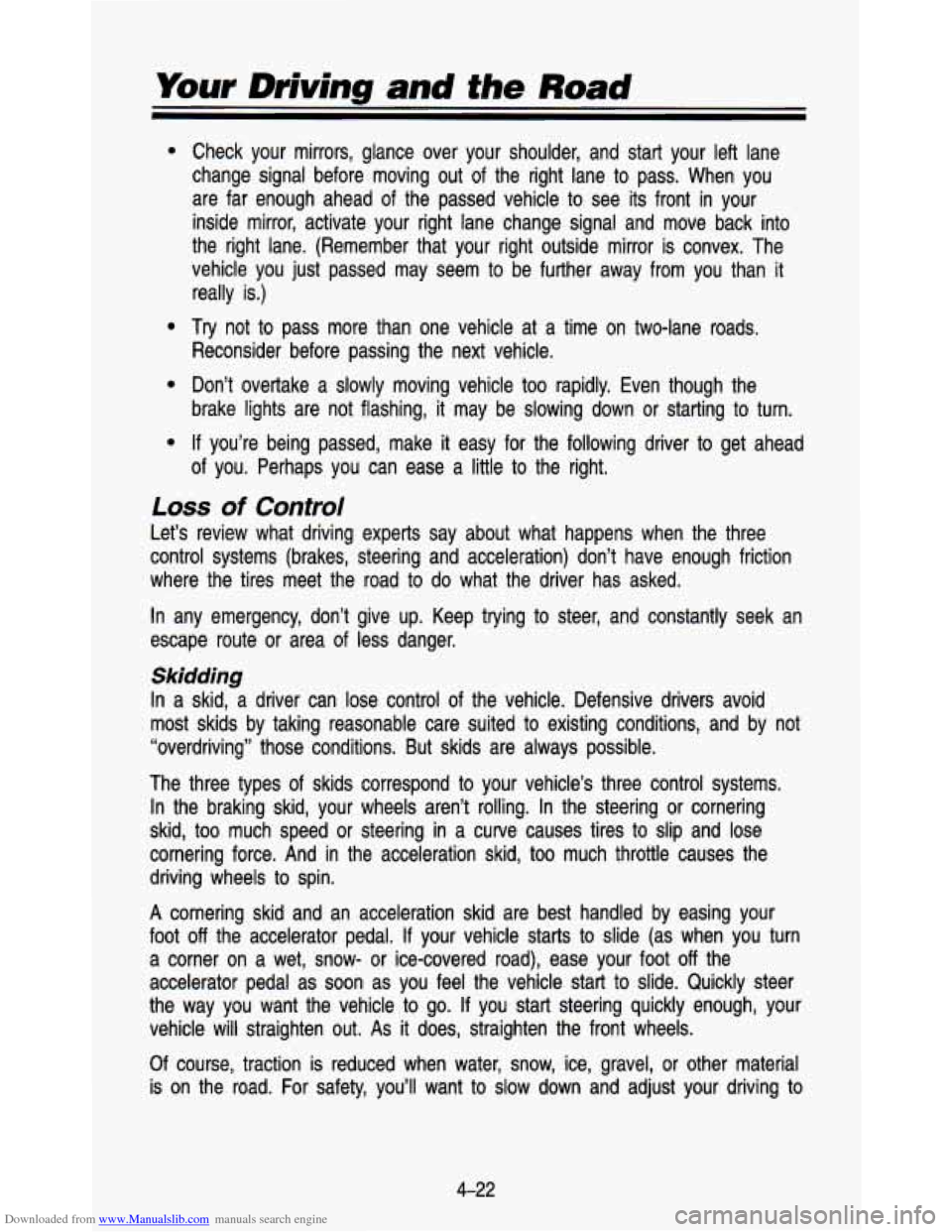
Downloaded from www.Manualslib.com manuals search engine Your Driving and the Road
0
Check your mirrors, glance over your shoulder, and start your \
left lane
change signal before moving out of the right lane
to pass. When you
are far enough ahead of the passed vehicle
to see its front in your
inside mirror, activate your right lane change signal and move \
back into
the right lane. (Remember that your right outside mirror is c\
onvex. The
vehicle you just passed may seem
to be further away from you than it
really
is.)
Try not to pass more than one vehicle at a time on two-lane roads.
Reconsider before passing the next vehicle.
Don’t overtake a slowly moving vehicle
too rapidly. Even though the
brake lights are not flashing, it may be slowing down or starting
to turn.
If you’re being passed, make it easy for the following driver
to get ahead
of you. Perhaps you can ease a little
to the right.
Loss of Control
Let’s review what driving experts say about what happens whe\
n the three
control systems (brakes, steering and acceleration) don’t ha\
ve enough friction
where the tires meet the road
to do what the driver has asked.
In any emergency, don’t give up. Keep trying
to steer, and constantly seek an
escape route or area of less danger.
Skidding
In a skid, a driver can lose control of the vehicle. Defensive drivers avoid
most skids by taking reasonable care suited to existing conditions, and by not
“overdriving” those conditions. But skids are always possib\
le.
The three types
of skids correspond to your vehicle’s three control systems.
In the braking skid, your wheels aren’t rolling. In the steering or cornering
skid,
too much speed or steering in a curve causes tires to slip and lose
cornering force. And in the acceleration skid,
too much throttle causes the
driving wheels
to spin.
A cornering skid and an acceleration skid are best handled by easing your
foot
off the accelerator pedal. If your vehicle starts to slide (as when you turn
a corner on a wet, snow- or ice-covered road), ease your foo\
t
off the
accelerator pedal
as soon as you feel the vehicle start to slide. Quickly steer
the way you want the vehicle
to go. If you start steering quickly enough, your
vehicle will straighten out.
As it does, straighten the front wheels.
Of course, traction is reduced when water, snow, ice, gravel, or other material
is on the road. For safety, you’ll want
to slow down and adjust your driving to
4-22
Page 177 of 345
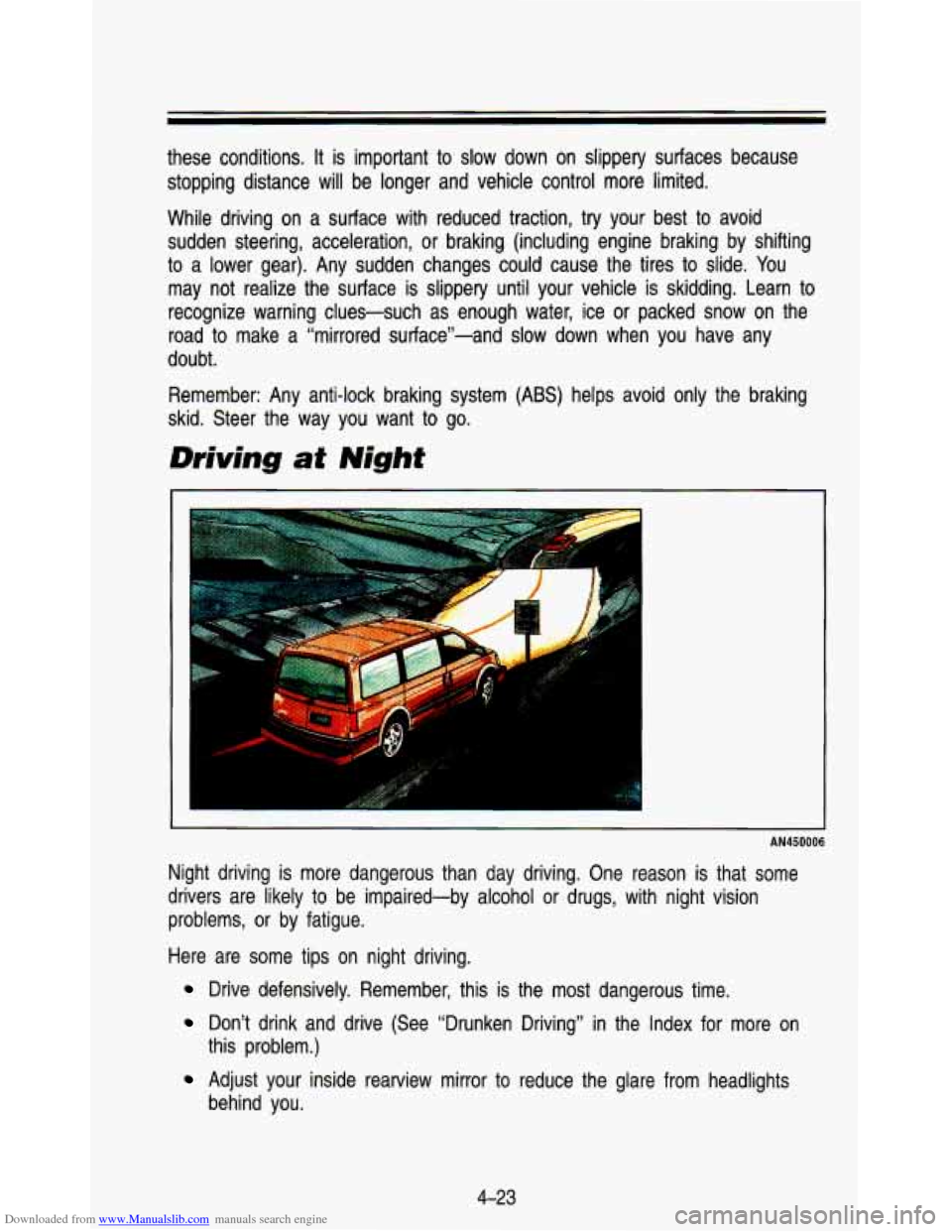
Downloaded from www.Manualslib.com manuals search engine these conditions. It is important to slow down on slippery surfaces because
stopping distance will be longer and vehicle control more limited.
While driving on a surface with reduced traction, try your best to avoid
sudden steering, acceleration, or braking (including engine brak\
ing by shifting
to a lower gear). Any sudden changes could cause the tires to s\
lide. You
may not realize the surface is slippery until your vehicle is skidding. Learn to
recognize warning clues-such as enough water, ice or packed sno\
w on the
road to make a “mirrored sutface”-and slow down when you have any\
doubt.
Remember: Any anti-lock braking system
(ABS) helps avoid only the braking
skid. Steer the way you want to go.
Driving at Night
AN450006
Night driving is more dangerous than day driving. One reason is that some
drivers are likely to be impaired-by alcohol or drugs, with night vision
problems, or by fatigue.
Here are some tips on night driving.
Drive defensively. Remember, this is the most dangerous time.
Don’t drink and drive (See “Drunken Driving” in the Index for more on
Adjust your inside rearview mirror to reduce the glare from he\
adlights
this problem.)
behind you.
4-23